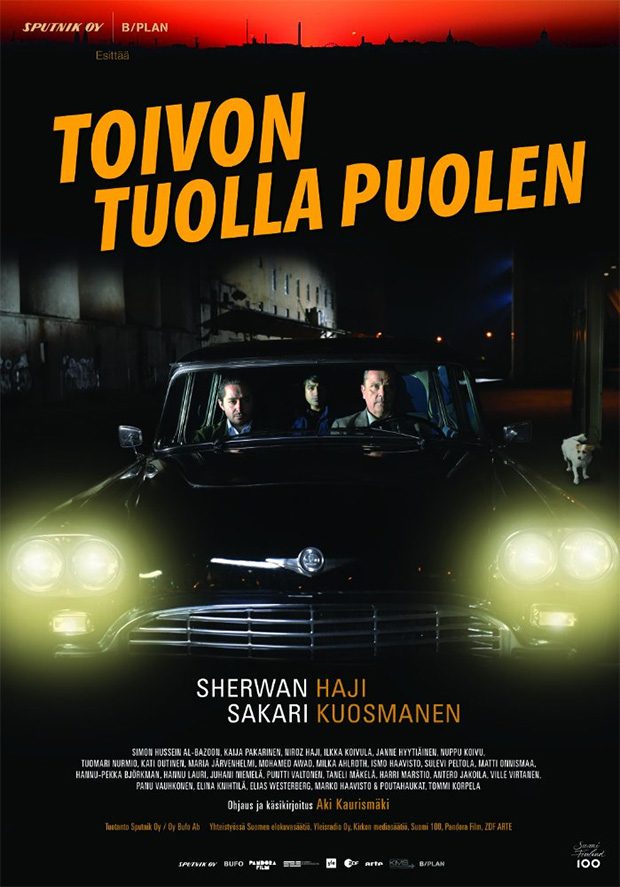The Other Side of Hope (Kaurismaki, 2017): Finland
Reviewed by Larry Gleeson during the Berlin Film Festival.

Writer/Director Aki Kaurismaki served up a full platter of entertainment with Toivon tuolla puolen (The Other Side of Hope) during the 67th Berlin International Film Festival at the Berlinale Palast Theater. Tackling the migration and asylum bureaucratic processing issues of the day, Kaurismaki serves up quite a treat with The Other Side of Hope.
The film opens in the dark of night in a shipping harbor complete with fog horn blasts and heavy equipment operating including a dock loader transferring coal from ship to shore. The black, glistening bituminous coal shimmering in the light as it is being piled is magical this night. Emerging from the center of the pile a rounded shape with two spherical orbs projecting light are visible. Soon a human form emerges.
A cut is made to a businessman, Wikstrom, played by Sakari Kuosmanen primping himself for what appears to be another day. Yet, on this day, Wikstrom has decided to leave his wife, who comes into frame with a full head of curlers, a cigarette dangling from her mouth, attired in a cheaply-made, tropical floral robe. Wikstrom places his wedding ban on the table and exits. The woman reached for a gin bottle pouring herself a double taking a mouthful to wrap up the scene.
Using these two main protagonists, Kaurismaki embarks on a story showcasing two very different lives. Wikstrom, a haberdasher of sorts peddling ties and men’s shirts, drives a black luxury sedan listening to Western music while the coal refugee, Khaled, a Syrian asylum seeker, portrayed by Sherwan Haji, takes a coin-fed shower releasing the black soot from his skin’s pores.
These men are on different trajectories. Khaled tries to do the right thing by finding the nearest police station in Helsinki to seek political sanctuary status from Aleppo. Despite his best efforts Khaled is denied sanctuary and decides to stay in the country illegally as many in his predicament seem to be doing. In juxtaposition, Wikstrom is hustling at a private, high-stakes poker game winning enough money to purchase outright an old, seemingly well-established restaurant in one of the remotest areas of Helsinki.
The restaurant undergoes several incarnations – each one bringing more laughs from the audience than the previous one. Tiina Kaukanen rapid fire costuming changes aids immensely in the humorous attempts to find a working restaurant motif. And, Wikstrom has developed very solid rapport with the chef and head waiter and takes to heart almost every one of their suggestions.
Khaled, on the other hand, has been living on the streets and has made friends with a hip and funky group of rock-n-rollers. As luck would have it, or, maybe it was a form of divine Providence, Wikstrom finds Khaled sleeping in the back of his restaurant and winds up giving him a bed and a job. With the help of the Wikstrom’s connections, Khaled is reunited with his sister and manages to find a way to stay in the country.
I would be amiss not to mention the uber strong production design managed by Mark Lwoff and Misha Jaari . Director of Photography, Timo Salminen, captures the film’s telling mise-en-scene with various lighting sets ranging from very low-key sets to more traditional tungsten indoor lighting set ups.
Hats off to Kaurismak. He wields quite a powerful wand in The Other Side of Hope. Bringing the main protagonists together after nearly forty minutes and having the story and its characters gel in a believable manner is no easy task. Quite the opposite.
An interesting note: Eevi Kareinen handled casting while serving as the Assistant Director. Not something a viewer would see in a US studio production.
In the end, Kaurismaki brings these two characters together – the practical businessman and a refugee seeking a life free from Syrian war for he and his sister – and gives the viewer a semi-utopian look at a humanistic and pragmatic way to not only survive in community but to thrive in community. Along the way, Kaurismaki provides plenty of comic relief resulting in a heart-warming and life-affirming tale of pragmatism, redemption and the joy of life. An exceptional film in light of the present migration dilemma and one I recommend highly without reservation.
About this entry
You’re currently reading “The Other Side of Hope (Kaurismaki, 2017): Finland,” an entry on Student Film Reviews
- Published:
- 03.04.17 / 6am
- Category:
- Berlin International Film Festival 2017, Films
26 Comments
Jump to comment form | comments rss [?]